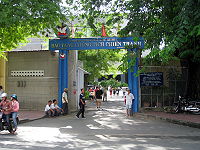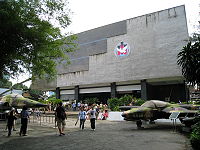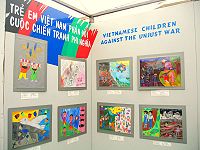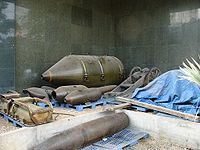
War Remnants Museum (Ho Chi Minh City)
Encyclopedia




Museum
A museum is an institution that cares for a collection of artifacts and other objects of scientific, artistic, cultural, or historical importance and makes them available for public viewing through exhibits that may be permanent or temporary. Most large museums are located in major cities...
at 28 Vo Van Tan, in District 3, Ho Chi Minh City
Ho Chi Minh City
Ho Chi Minh City , formerly named Saigon is the largest city in Vietnam...
, Vietnam
Vietnam
Vietnam – sometimes spelled Viet Nam , officially the Socialist Republic of Vietnam – is the easternmost country on the Indochina Peninsula in Southeast Asia. It is bordered by China to the north, Laos to the northwest, Cambodia to the southwest, and the South China Sea –...
. It primarily contains exhibits relating to the American
United States
The United States of America is a federal constitutional republic comprising fifty states and a federal district...
phase of the Vietnam War
Vietnam War
The Vietnam War was a Cold War-era military conflict that occurred in Vietnam, Laos, and Cambodia from 1 November 1955 to the fall of Saigon on 30 April 1975. This war followed the First Indochina War and was fought between North Vietnam, supported by its communist allies, and the government of...
.
Operated by the Vietnamese government, the museum was opened in September 1975 as "The House for Displaying War Crimes of American Imperialism and the Puppet Government [of South Vietnam
South Vietnam
South Vietnam was a state which governed southern Vietnam until 1975. It received international recognition in 1950 as the "State of Vietnam" and later as the "Republic of Vietnam" . Its capital was Saigon...
]." Later it was known as the Museum of American War Crimes, then as the War Crimes Museum until as recently as 1993. Its current name follows liberalization in Vietnam and the normalization of relations with the United States.
The museum comprises a series of eight themed rooms in several buildings, with period military equipment located within a walled yard. The military equipment include a UH-1 "Huey"
UH-1 Iroquois
The Bell UH-1 Iroquois is a military helicopter powered by a single, turboshaft engine, with a two-bladed main rotor and tail rotor. The helicopter was developed by Bell Helicopter to meet the United States Army's requirement for a medical evacuation and utility helicopter in 1952, and first flew...
helicopter, an F-5A fighter, a BLU-82
BLU-82
The BLU-82B/C-130 weapon system, known under program "Commando Vault" and nicknamed "daisy cutter" in Vietnam and in Afghanistan for its ability to flatten a forest into a helicopter landing zone, is a 15,000 pound conventional bomb, delivered from either a C-130 or an MC-130 transport aircraft....
"Daisy Cutter" bomb, M48 Patton tank
M48 Patton
The M48 Patton is a medium tank that was designed in the United States. It was the third and final tank to be officially named after General George S. Patton, commander of the U.S. Third Army during World War II and one of the earliest American advocates for the use of tanks in battle It was a...
, and an A-1
A-1 Skyraider
The Douglas A-1 Skyraider was an American single-seat attack aircraft that saw service between the late 1940s and early 1980s. It became a piston-powered, propeller-driven anachronism in the jet age, and was nicknamed "Spad", after a French World War I fighter...
attack bomber.
One building reproduces the "tiger cages" in which the South Vietnamese government housed political prisoners. Other exhibits include graphic photographs, accompanied by short copy in English, Vietnamese and Japanese, covering the effects of Agent Orange
Agent Orange
Agent Orange is the code name for one of the herbicides and defoliants used by the U.S. military as part of its herbicidal warfare program, Operation Ranch Hand, during the Vietnam War from 1961 to 1971. Vietnam estimates 400,000 people were killed or maimed, and 500,000 children born with birth...
and other chemical defoliant
Defoliant
A defoliant is any chemical sprayed or dusted on plants to cause its leaves to fall off. A classic example of a highly toxic defoliant is Agent Orange, which the United States armed forces used abundantly to defoliate regions of Vietnam during the Vietnam War from 1961 to 1970.Defoliants differ...
sprays, the use of napalm
Napalm
Napalm is a thickening/gelling agent generally mixed with gasoline or a similar fuel for use in an incendiary device, primarily as an anti-personnel weapon...
and phosphorus
Phosphorus
Phosphorus is the chemical element that has the symbol P and atomic number 15. A multivalent nonmetal of the nitrogen group, phosphorus as a mineral is almost always present in its maximally oxidized state, as inorganic phosphate rocks...
bombs, and atrocities such as the My Lai massacre
My Lai Massacre
The My Lai Massacre was the Vietnam War mass murder of 347–504 unarmed civilians in South Vietnam on March 16, 1968, by United States Army soldiers of "Charlie" Company of 1st Battalion, 20th Infantry Regiment, 11th Brigade of the Americal Division. Most of the victims were women, children , and...
. Curiosities include a guillotine
Guillotine
The guillotine is a device used for carrying out :executions by decapitation. It consists of a tall upright frame from which an angled blade is suspended. This blade is raised with a rope and then allowed to drop, severing the head from the body...
used by the French and the South Vietnamese to execute prisoners, last in 1960, and three jars of preserved human fetus
Fetus
A fetus is a developing mammal or other viviparous vertebrate after the embryonic stage and before birth.In humans, the fetal stage of prenatal development starts at the beginning of the 11th week in gestational age, which is the 9th week after fertilization.-Etymology and spelling variations:The...
es deformed by exposure to dioxin.
There are a number of unexploded ordnance
Unexploded ordnance
Unexploded ordnance are explosive weapons that did not explode when they were employed and still pose a risk of detonation, potentially many decades after they were used or discarded.While "UXO" is widely and informally used, munitions and explosives of...
stored in the corner of the yard, seemingly with their charges removed.

